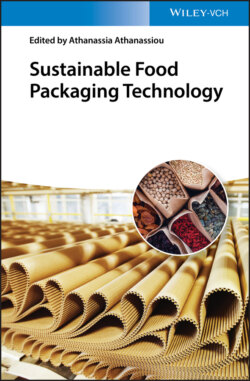Читать книгу Sustainable Food Packaging Technology - Группа авторов - Страница 28
1.3.11.2 Wheat Gluten
ОглавлениеWG is a protein complex having two major components, known as glutenin and gliadin. It is composed of proteins containing water‐insoluble and ethanol‐soluble prolamins and water‐ and ethanol‐insoluble glutelins (70–80 wt%) in combination with small amounts of wheat oils, starch, and insoluble hemicellulose [125]. The gliadins are mainly monomeric single chain polypeptides, whereas the glutenins are polymeric and disulfide linked polymeric chains [126]. These components are responsible for the physical and chemical properties of WG and confer it with higher viscoelastic properties compared with other plant proteins [127, 128]. WG has been used for the production of sustainable food packaging because it is a renewable raw material, available in large quantities, fully biodegradable, and inexpensive. It has properties suitable for applications in edible films and biodegradable packaging. The methods used for processing WG‐based bioplastics are casting, extrusion, and compression molding [129, 130]. WG‐based films have exceptional oxygen and carbon dioxide barrier properties. However, they have lower water vapor barrier, mechanical strength, and thermal properties in comparison with conventional plastic films [131, 132]. Lignocellulosic reinforcement fillers have been used to improve the properties of WG since they can interact with proteins and lead to the formation of protein–polyphenol complexes, allowing a higher flexural strength, tensile strength, and modulus [133, 134]. Also, WG/montmorillonite (MMT) films were prepared by melt mixing and thermoforming [135]. The introduction of up to 5 wt% of MMT increased the mechanical properties in ways that were not possible by just the variation of the glycerol content and the processing temperature.
Figure 1.8 Scheme of the gelatin manufacturing from denaturation of collagen for film formation.
